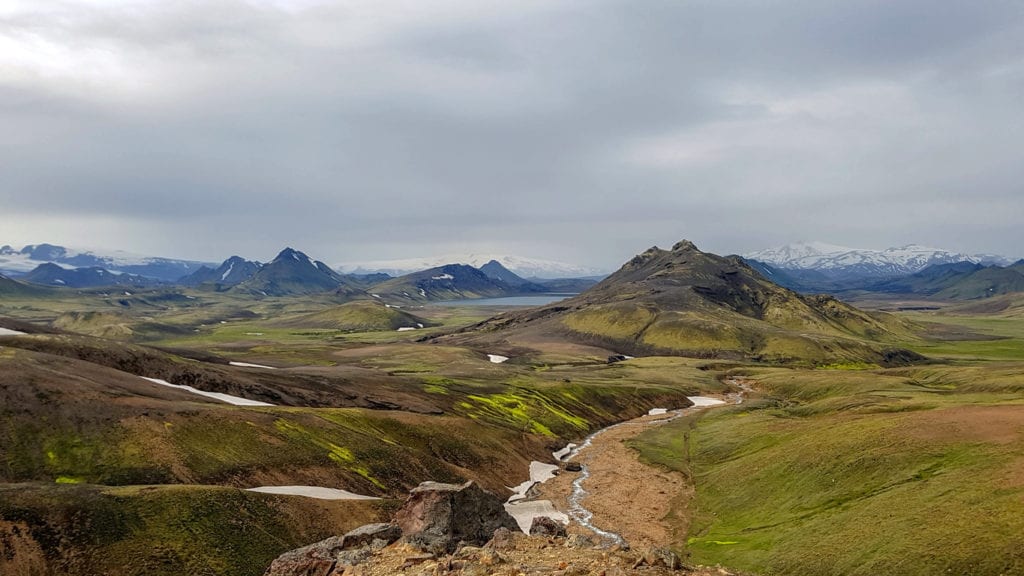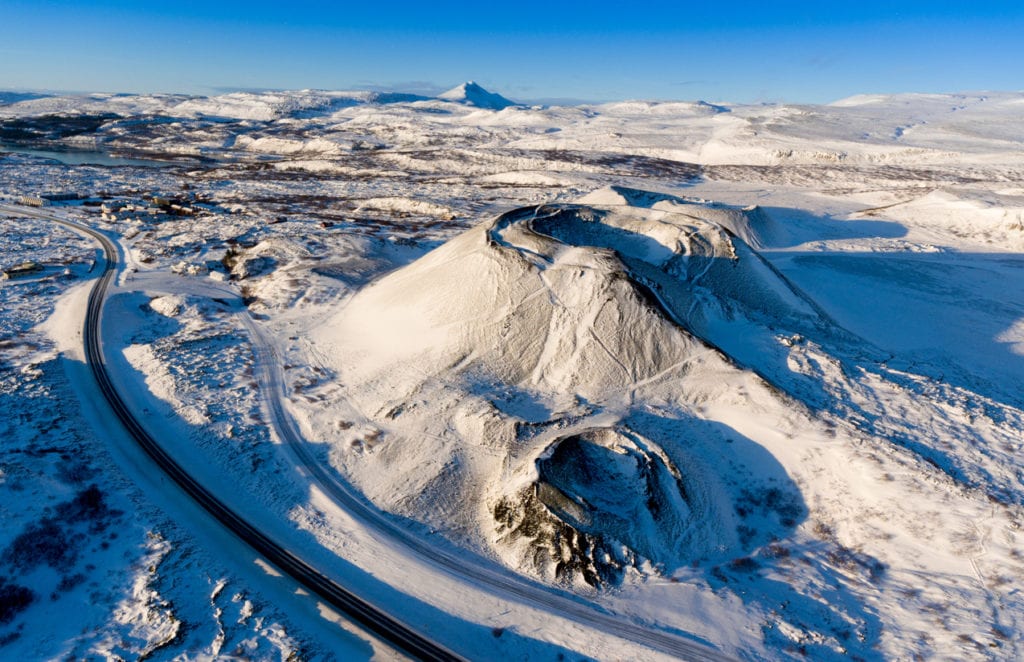Iceland is called the Land of Ice and Fire for a reason. Located on the mid-Atlantic ridge, the island is a volcanic hotspot, occasionally plagued by eruptions such as the 2010 eruption of Eyjafjallajökull, which is remembered for causing massive disruptions to air travel in Europe. Of course, the hotspot is also a great benefit to the island, providing amazing thermal pools and cheap energy. Volcanoes in Iceland also shaped the landscape. Indeed, the first thing most visitors to the island see is the black lava fields that surround Keflavik airport.
For many visitors, thus, the idea of actually seeing a volcano might be appealing. There are, after all, thirty active systems on the island, resulting in about 130 individual volcanoes, active or inactive. So, can you?
What Causes Iceland’s Volcanic Activity?
Iceland sits across the mid-Atlantic ridge, where the North American and Eurasian plates are being pushed apart. This causes magma to rise up into the gap, creating new land. The Þingvellir valley is growing by 2.5 centimeters a year. The pressure the magma is under causes frequent eruptions, at least one a decade. Sometimes these eruptions cluster.
The most recent eruption was Holuhraun in 2014. However, there may have been others. Sometimes, eruptions happen under thick glaciers and don’t break the ice.
Is It Safe to Visit Volcanoes in Iceland?
You might want to know whether visiting and observing a volcano is safe. In fact, the threat to human life is minimal. Although the Eyjafjallajökull eruption caused huge economic issues, there were no casualties. The early settlers had the sense to build away from active volcanoes in Iceland.
Iceland’s volcanoes are thoroughly monitored by seismologists and the area will be cleared if an active eruption or a jökulhlaup – a flash flood caused by a subglacial eruption – is suspected.
In fact, the biggest risk is reduced air quality or in some cases poisoned gas. After the Holuhraun eruption, thousands of sheep died.
Because of all of the monitoring and the expertise of the locals, excursions to see volcanoes are very safe. If there’s an eruption, you should be able to book a tour if an eruption does happen, managed by a guide who will know exactly how to give you a good look at the flowing lava without anyone getting hurt. You should not, however, approach an active eruption without a guide or enter an evacuation zone. For currently inactive volcanoes, you can often drive to the volcano and explore independently. For some sites, though, a guide is still recommended.
What Volcanoes in Iceland Should I Visit?
It’s impossible not to have your Iceland trip influenced by volcanoes. Unless you go to the extreme west of the island, you will be in a volcanic landscape, influenced by lava flows, glacial runoff, cones and craters. There are some volcanoes near Reykjavik, but to properly go hunting you will need to rent a car. Here are some of the best volcanoes in Iceland to visit and how.
Eyjafjallajökull

Eyjafjallajökull’s infamy had made it a popular attraction. The best view of the volcano is from the air. It’s covered with an ice cap, and it’s currently inactive (since 2010). You can also take a super jeep tour of the area around the volcano and appreciate the Thorsmork Valley with some wonderful views of the volcano.
You can get to the volcano by driving along the South Shore. Stop at Þorvaldseyri visitor center for an exhibition about the 2010 eruption and the volcano in general. You can’t drive that close to the volcano, however, due to rugged terrain and poor roads, so consider taking a tour to get a better view.
Þríhnúkagígur
If you are interested in how volcanoes work…or just a truly unique experience, then make sure to visit Þríhnúkagígur (Thrihnukagigur). Why? It’s the only volcano in the world you can go inside. Dormant for 4000 years, the volcano is essentially dead, making going inside it completely safe. The tours descend into the magma chamber by a small mining lift. The chamber is huge and beautifully colored, with the walls stained red, green, and yellow.
This is a summer-only attraction and you do need to hike a short distance uphill to reach the entrance. It is not accessible. You can take a hotel pickup tour from Reykjavik or drive to the volcano, meeting the tour at a ski cabin. Make sure to drive to Breiðabliksskáli not the volcano itself. If it’s unpleasant, you can wait inside the ski lodge for your guide. Tours should be booked in advance.
Hekla
Hekla is sometimes called the “Gateway to Hell” and superstitious locals claim witches gather there to meet the devil.. This hugely active volcano is known for spewing out large quantities of lava and it has been active to some degree since 1104.
Because of its activity, Hekla is the site of a lot of research. Studying volcanoes in Iceland has resulted in advances in ash plume monitoring, starting with an accident when a NASA monitoring plane flew right into an ash plume (they took damage but got good readings).
If you are fit, hiking to the summit is possible. Allow 8 hours. The easy route is from the northwest side. This is by far the best way to see Hekla, but if you are not used to mountain hiking you should find a guide or join a group of hikers. The route is only partially marked.
If you rented a 4×4 car, take the route to Landmannalaugar for a better view of the mountain. With a normal vehicle you can still see Hekla from route one. It is between Road 26 and the Friðland að Fjallabaki Nature Reserve.
Katla
Katla is a neighbor of Eyjafjallajökull and when one goes off, the other often follows. This means Katla is long overdue for another eruption. It is also very difficult to reach. You can see Katla when driving the south coast, but getting a really good view of this highly active volcano and its outlet glaciers really requires a helicopter tour. You may also be able to find a super jeep tour. Another popular alternative is to take a glacier hike on Sólheimajökull, which will give you great views of the volcano. (Do not attempt to hike on the glacier without a guide and proper equipment. People get hurt that way regularly).
Despite being overdue for an eruption it’s safe to visit due to heavy monitoring. If you are really lucky you may even get to witness the eruption.
Snaefellsjökull

In 1992, for some reason, thousands of people became convinced that aliens would land on Snaefellsjökull at midnight on November 5. Because people are weird.
It’s also the volcano Jules Verne used as the site for his cave leading to the earth’s core. This makes it one of the most beloved volcanoes in Iceland. It’s known for it’s beauty, so take your camera. It is located in Snaefellsjökull National Park. The park is northwest of Reykjavik and is well worth a visit, even if you plan on focusing on the south of Iceland. It’s also on the way to the Westfjords. The best way to get there is along Route 1, but you can cut an hour off your trip by going through the Hvalfjörður tunnel (at the cost of an about $10 toll). Unlike many U.S. parks, the park is not heavily signed.
While you are there, visit Saxhóll Volcano Crater. There are stairs, so you don’t have to be a climber to get up to the top of the crater, although you should still be very careful. You can also take a tour of Vatnshellir, an 8,000-year-old lava tube system. In other words, you can easily spend a day or even two days in the park.
Hverjhall
A lot of volcano hikes are challenging, perhaps requiring a guide or even knowledge of mountaineering. The nice thing about Hverfjall is pretty much anyone comfortable on their feet can do it. A one hour hike will take you up to, and around, the crater ring and it’s easy to get from the Ring Road. This one is in the north of Iceland, right next to Lake Mývatn.
And yes, it’s perfectly safe: Hverjhall has been dormant for about 4,500 years. It’s a tephra cone, which makes for a spectacular formation. Because it’s such an easy hike, it’s a great volcano to visit if you have kids.
Askja
If you’re into thermal pools and volcanoes, Askja will give you a twofer; a small caldera adjacent to the vast lake contains a geothermal pool that is warm enough to bathe in comfortably. The main lake is frozen for much of the year.
Oh, and if you’re interested in space history? The area around Askja is so dry and free of vegetation that it was used for training during the Apollo program; it’s the most moonlike place on Earth. You can take a tour that gives you a great view of the crater, talks about that history, and also includes a local nature reserve and a bathe in Viti.
Find More Volcanoes in Iceland
There are, of course, many more volcanoes in Iceland, and talking to locals might give you a line on an interesting place to visit that is further off the beaten track than these. However, all of these are easy to get to if you are renting a car in Iceland and driving the ring route. Consider adding a volcano or two to your Iceland road trip and gain more of an understanding of this fascinating landscape.
Find more interesting articles about Iceland and useful travel tips on our site and plan your visit to this beautiful, remote island.
Back